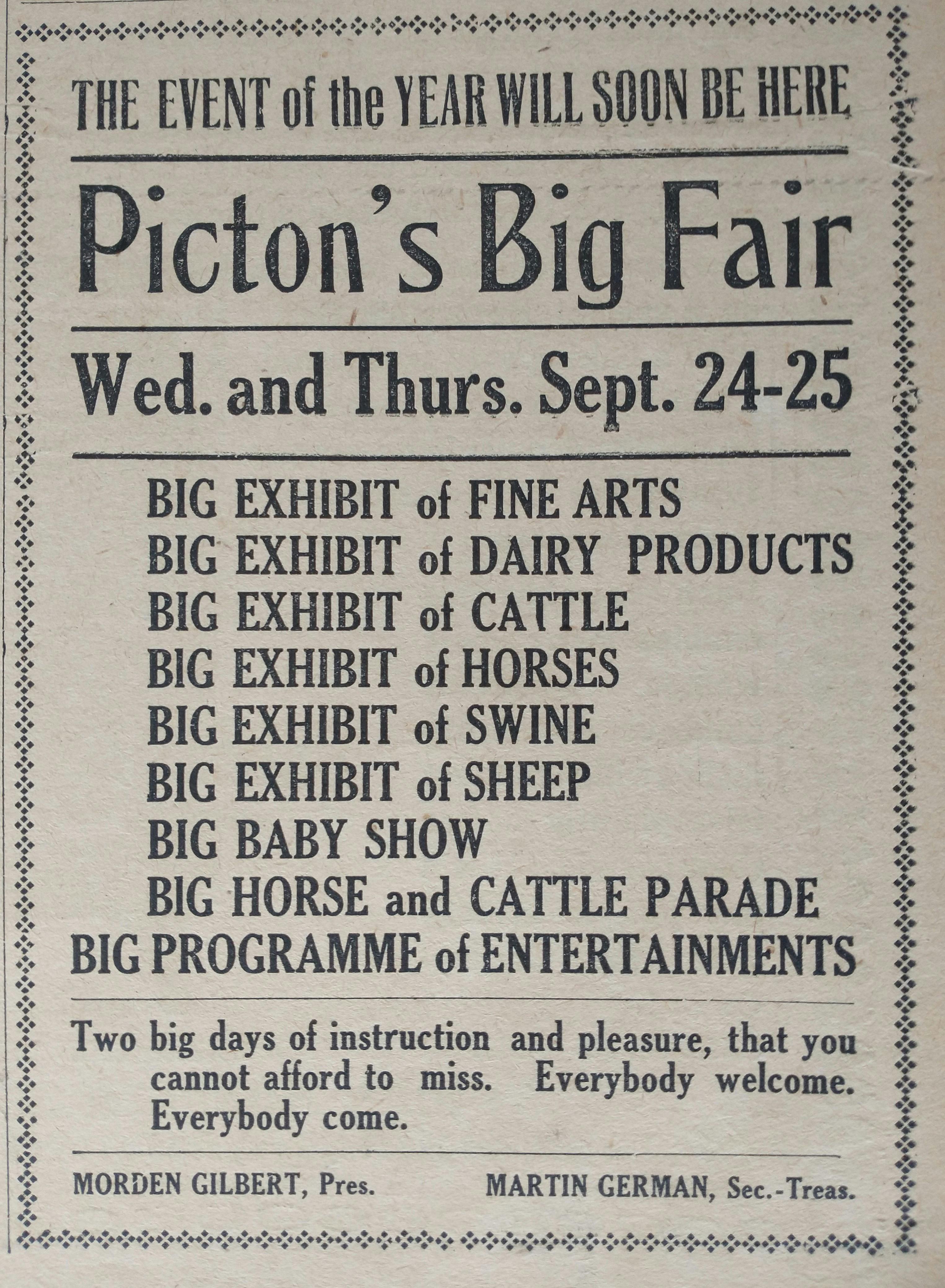
The Fall Fair has been a feature of life in the County for almost as long as the Gazette. Not that it’s a contest or anything.
The Prince Edward County Agricultural Society formed in 1831 and within a couple of years could boast 100 members. The first thing to which it turned its attention was improving the County’s sheep and cattle stock, and, alongside these efforts, encouraging the growth of rich, green, and plentiful clover. Each township soon had a Branch Society.
The first fair was held, by petition to the Lieutenant-Governor of the province, in 1836. A combination of government grants and private donations contributed to its success.
In addition to prizes for best animals, cheese, flannel, and “domestic socks,” awards promoted agricultural development. “Most improved farm” was a category, and included any farm with at least 50 acres of cultivated land.
The fair has been held at its current location since 1886, with the Crystal Palace and the grandstand as key features.
“Watch for them! Wait for them! Picton Fair Days,” was advertised in 1908, “the days on which old acquaintances are renewed, and everybody meets everybody else in a spirit of comradeship such as only can be found at a County Fair.”
The report following the event confirmed that they “were red letter days for Picton. It was generally a holiday for citizens of the town and farmers of the county, alike; all mingled in one merry jostling hot throng and wended their way to the Agricultural Society’s Park with the fair of 1908 their mecca.” In that year, a baseball match between Picton and Kingston was a feature, as well as the entertainments of the Sunny South Minstrel Band. There was some concern that there weren’t enough exhibits: “The Palace was altogether too sparsely filled.”
The exhibitions organized by the Agricultural Society every fall quickly became a point of pride for the whole County. In preparation for the 1903 Fair, this newspaper urged its readers, “Now let everyone do what they can to make the coming show as pronounced a success as possible. We do not want to disappoint the people who come here on this occasion by providing them with a meagre bill of fare, but every citizen should be imbued with the desire to make the show as attractive as possible, so that those who come may continue to be yearly visitors.”
But the Fair was never intended just to attract outsiders. It originated with the aim of encouraging agricultural development, by way of sharing ideas as well as friendly competition, as growers, farmers, and all practitioners of animal husbandry vied for the prizes on offer.
In a notice called “Mammoth Apples,” published on 28 September 1860, the Gazette wrote, “Mr. Byron Williams, of the Township of Athol, will please accept our thanks for a fine collection of apples; the largest of which measures 14 inches in circumference. It is not often that we are favoured with such occular demonstrations of friendship, and when we are, the fact is too good to keep. Who can beat them?”
One week later, Mr. R. B. Werden took up the gauntlet. “I will accept the challenge, either in size, quality, or variety; therefore bring on your Apples, and we will meet at the Agricultural Show at Picton, where we will let the community, or a committee, judge for themselves. I will not surrender until beaten by fair play. I am glad to see a spirit of enterprise on the part of Horticulturists, as it is very much needed in this district, where such fruit can be raised, as you will see at the show.”
The following week featured a report on Mr. Werden’s fruit. “He exhibited 56 varieties of Apples; some specimens of mammoth size, called the Pound Apple, for a late kind, took the preference, on account of their size and smoothness. —Mr. G. A. Sargeant, of Bloomfield, exhibited a large and splendid assortment of Apples, about 50 varieties, which were very much admired. Not having had an opportunity to taste all the different varieties of apples, we cannot accurately judge of their qualities, but must acknowledge that we were proud of the display and felt no misgivings as to their real worth. There were other apples and pears on exhibition, but we considered Mr. Werden and Mr. Sargeant to be without a successful rival.”
In the end, Mr. Werden won first prize ($1.25) and Mr. Sargeant both second ($1.00) and fourth (50 cents). (Both were also awarded for their pears.) Mr. Byron was not mentioned.
By the early twentieth century, the Fair could (and did) brag that it was “the best fair in the whole Dominion of Canada,” according to J. Lockie Wilson, Superintendent of Fall Fairs and Exhibitions, who apparently said this of the Picton Fair in 1916. A 1923 advertisement rehearsed the tale, with some fine print: “outside of those conducted in Toronto, London and Ottawa.”
This year’s Fair takes place 8-10 September. For full information and tickets, visit pictonfair.ca.
—with files from Phil Dodds. The outlines of the history presented here have been gleaned from the many Gazette articles of Phil Dodds (1906-90), who was an active member of the Agricultural Society as its secretary for over 50 years. He was reporter and then Editor of the Picton Gazette for over 40 years, and a tireless contributor to the life of the County for all 84 of his years, and then some.
See it in the newspaper